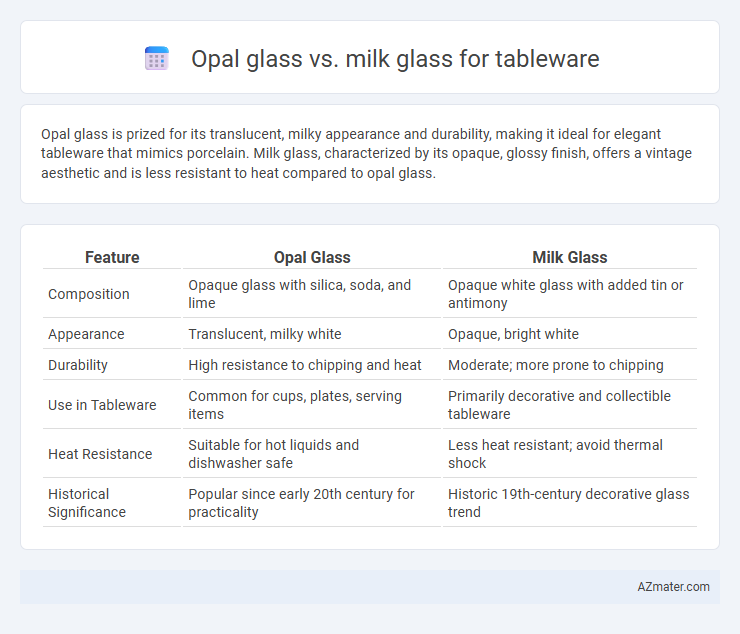Opal glass is prized for its translucent, milky appearance and durability, making it ideal for elegant tableware that mimics porcelain. Milk glass, characterized by its opaque, glossy finish, offers a vintage aesthetic and is less resistant to heat compared to opal glass.
Table of Comparison
| Feature | Opal Glass | Milk Glass |
|---|---|---|
| Composition | Opaque glass with silica, soda, and lime | Opaque white glass with added tin or antimony |
| Appearance | Translucent, milky white | Opaque, bright white |
| Durability | High resistance to chipping and heat | Moderate; more prone to chipping |
| Use in Tableware | Common for cups, plates, serving items | Primarily decorative and collectible tableware |
| Heat Resistance | Suitable for hot liquids and dishwasher safe | Less heat resistant; avoid thermal shock |
| Historical Significance | Popular since early 20th century for practicality | Historic 19th-century decorative glass trend |
Introduction to Opal Glass and Milk Glass Tableware
Opal glass tableware is characterized by its translucent, milky appearance created by adding small amounts of opacifiers to molten glass, resulting in elegant and durable items ideal for everyday use and formal dining. Milk glass, originating in the 19th century, is an opaque white glass made by incorporating tin or other substances during production, prized for its vintage charm and decorative appeal in table settings. Both materials offer unique aesthetic qualities and functional benefits, making them popular choices for collectors and households seeking classic or contemporary styles.
Defining Opal Glass: Composition and Characteristics
Opal glass is a type of translucent glass characterized by its milky white appearance achieved through the inclusion of phosphates and fluorides within the silica base. Its composition provides durability and resistance to thermal shock, making it ideal for both everyday tableware and decorative pieces. The smooth, glossy surface coupled with subtle translucency distinguishes opal glass from the more opaque, porcelain-like finish of milk glass.
Understanding Milk Glass: History and Features
Milk glass, originating in the 16th century, is characterized by its opaque, white appearance created through the addition of tin oxide or other opacifiers in molten glass. Its popularity surged during the Victorian era, prized for its durability and decorative appeal in tableware, often featuring intricate patterns and a smooth, glossy finish. Milk glass serves both functional and aesthetic purposes, offering a unique blend of vintage charm and practical use for everyday dining sets.
Aesthetic Differences: Opal Glass vs Milk Glass
Opal glass offers a translucent, milky white appearance that allows light to softly diffuse through, creating an elegant, luminous effect ideal for refined table settings. Milk glass, by contrast, is opaque with a solid, creamy white finish that provides a vintage or classic look, often showcasing embossed or intricate patterns more prominently. The visual contrast between opal glass's gentle glow and milk glass's bold opacity significantly influences the overall aesthetic ambiance of tableware collections.
Durability and Strength Comparison
Opal glass offers superior durability and impact resistance compared to milk glass, making it less prone to chipping or cracking during everyday use. Milk glass, while aesthetically pleasing with its opaque finish, tends to be more fragile due to its composition and can chip or break more easily under stress. For tableware requiring frequent handling and washing, opal glass provides a stronger, longer-lasting option that withstands thermal shocks better than milk glass.
Safety and Food Compatibility
Opal glass and milk glass both offer non-porous surfaces that resist stain and odor absorption, making them highly safe and compatible with food. Opal glass is generally more heat-resistant and less prone to chipping, enhancing durability and safety for everyday use and dishwasher cleaning. Milk glass, while elegant and food-safe, may be more susceptible to surface scratches over time, which can harbor bacteria if not properly maintained.
Price and Availability of Opal and Milk Glass
Opal glass tableware generally offers a higher price point due to its denser, more durable composition and limited manufacturing sources compared to milk glass. Milk glass, known for its wide availability and historical production, is often more affordable and easier to find in both vintage and modern markets. Availability of opal glass is typically limited to specialty retailers and premium collections, whereas milk glass enjoys broader distribution across thrift stores, online auctions, and mainstream retailers.
Popular Uses in Modern Table Settings
Opal glass is favored for its translucent quality, making it ideal for contemporary table settings that emphasize elegance and light diffusion, such as minimalist dinnerware and stylish drinkware. Milk glass, with its opaque white finish, is commonly used in vintage-inspired or rustic-themed tablescapes, popular for decorative serving bowls, platters, and candle holders. Both materials are prized for durability and aesthetic versatility, with opal glass often featured in modern casual dining and milk glass preferred for statement pieces in eclectic or farmhouse designs.
Care and Maintenance Tips
Opal glass tableware requires gentle hand washing with mild detergent to prevent scratches and maintain its translucent quality, avoiding sudden temperature changes to reduce the risk of cracking. Milk glass is more durable but should still be cleaned using non-abrasive sponges and lukewarm water to preserve its opaque finish and prevent surface dulling. Both materials benefit from thorough drying with a soft cloth to avoid water spots and maintain their aesthetic appeal over time.
Choosing the Best Glass for Your Tableware Collection
Opal glass offers a translucent, slightly glossy finish that enhances the aesthetic appeal and light diffusion on your tableware, making it ideal for formal dining settings. Milk glass, characterized by its opaque, creamy white appearance, provides a vintage charm and durability, perfect for everyday use and rustic-themed collections. Selecting between opal and milk glass depends on your preference for visual elegance versus traditional robustness, ensuring your tableware aligns with both function and decor.

Infographic: Opal glass vs Milk glass for Tableware
 azmater.com
azmater.com